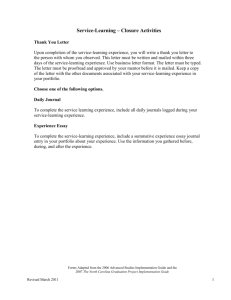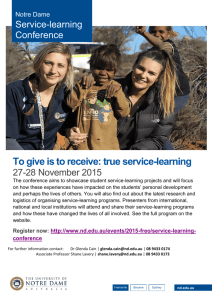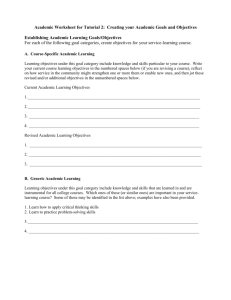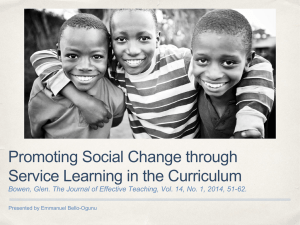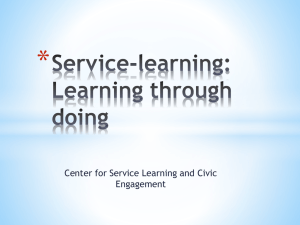Document 10465105
advertisement
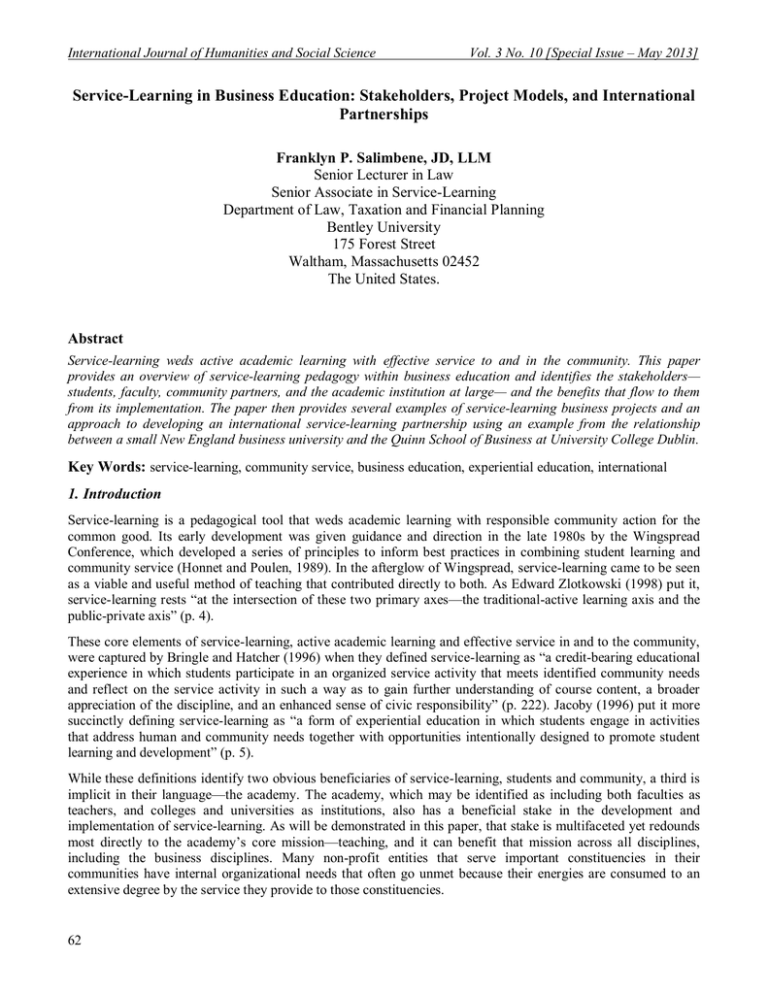
International Journal of Humanities and Social Science Vol. 3 No. 10 [Special Issue – May 2013] Service-Learning in Business Education: Stakeholders, Project Models, and International Partnerships Franklyn P. Salimbene, JD, LLM Senior Lecturer in Law Senior Associate in Service-Learning Department of Law, Taxation and Financial Planning Bentley University 175 Forest Street Waltham, Massachusetts 02452 The United States. Abstract Service-learning weds active academic learning with effective service to and in the community. This paper provides an overview of service-learning pedagogy within business education and identifies the stakeholders— students, faculty, community partners, and the academic institution at large— and the benefits that flow to them from its implementation. The paper then provides several examples of service-learning business projects and an approach to developing an international service-learning partnership using an example from the relationship between a small New England business university and the Quinn School of Business at University College Dublin. Key Words: service-learning, community service, business education, experiential education, international 1. Introduction Service-learning is a pedagogical tool that weds academic learning with responsible community action for the common good. Its early development was given guidance and direction in the late 1980s by the Wingspread Conference, which developed a series of principles to inform best practices in combining student learning and community service (Honnet and Poulen, 1989). In the afterglow of Wingspread, service-learning came to be seen as a viable and useful method of teaching that contributed directly to both. As Edward Zlotkowski (1998) put it, service-learning rests “at the intersection of these two primary axes—the traditional-active learning axis and the public-private axis” (p. 4). These core elements of service-learning, active academic learning and effective service in and to the community, were captured by Bringle and Hatcher (1996) when they defined service-learning as “a credit-bearing educational experience in which students participate in an organized service activity that meets identified community needs and reflect on the service activity in such a way as to gain further understanding of course content, a broader appreciation of the discipline, and an enhanced sense of civic responsibility” (p. 222). Jacoby (1996) put it more succinctly defining service-learning as “a form of experiential education in which students engage in activities that address human and community needs together with opportunities intentionally designed to promote student learning and development” (p. 5). While these definitions identify two obvious beneficiaries of service-learning, students and community, a third is implicit in their language—the academy. The academy, which may be identified as including both faculties as teachers, and colleges and universities as institutions, also has a beneficial stake in the development and implementation of service-learning. As will be demonstrated in this paper, that stake is multifaceted yet redounds most directly to the academy’s core mission—teaching, and it can benefit that mission across all disciplines, including the business disciplines. Many non-profit entities that serve important constituencies in their communities have internal organizational needs that often go unmet because their energies are consumed to an extensive degree by the service they provide to those constituencies. 62 The Special Issue on Arts and Social Science © Center for Promoting Ideas, USA www.ijhssnet.com Business students engaged in study at near-by universities, however, can make significant contributions to the local non-profit sector by applying their skill set and knowledge base to projects that enhance the organizational capacity of non-profits to provide quality service. Whether the need is a marketing strategy, a financial plan, an environmental audit, or the development of a database, business students can render an invaluable community service by delivering these products to non-profits. While traditionally such service has been rendered in localities close to campus, the potential exists for universities to develop international partnerships that provide opportunities for service-learning in the global environment. In discussing service-learning and its stakeholders, this paper will refer at times to the service-learning program of a small business university in New England, a program with both local and international elements. The program, which is referenced in this paper as the New England program, was established in the early 1990s. At the time, the New England program identified its goal as being one that combines traditional academic excellence with social service (Zlotkowski, 1998). That remains its goal today. In fact, in 2008, as a result of the quality of its servicelearning program, the New England University was classified by the Carnegie Foundation for the Advancement of Teaching as a “Community Engagement Institution” (Carnegie Foundation, 2013). 2. Service-Learning Stakeholders 2.1. Students as Stakeholders Students have much to gain as service-learning stakeholders. The research literature confirms a number of positive impacts of service-learning on student learning and attitude. In their oft-cited survey of service-learning, Eyler, Giles, and Gray (2000) found general agreement that service-learning promoted students’ academic learning, practical application of learning, critical thinking skills, leadership and communication skills, crosscultural understanding, and commitment to service. While it is appropriate to note as Strage (2000) does that there is a wide range of what passes for service-learning that creates challenges for researchers who measure servicelearning impacts, some or all of Eyler, Giles, and Gray’s findings are echoed elsewhere (Fenzel and Peyrot, 2005; Gallini and Moely, 2003; Lamb, Lee, Swinth, and Vinton, 2000; Moely, McFarland, Miron, Mercer, and Ilustre, 2002). Supplementing and supporting the findings of the research literature is the actual experience of business students. As an example, self-reporting surveys of students at the New England University undertaken between 2002 and 2011, indicate that through service-learning students develop an ability to apply their learning in practical situations, develop leadership skills, and believe they “make a difference” in the community. Not surprising for business students, their objectives are more often practical than strictly academic. So for example, while most business students self-reported that they want their service-learning experience to help them better understand course material, they also reported that they want their service-learning experience to help them get a better grade and add value to their resumes. In sum, through service-learning students seek to enhance their academic performance, make a meaningful contribution to the community, and advance their professional marketability. 2.2. Faculty as Stakeholders As with student goals, faculty goals generally operate within the same two spheres—the academic and the practical. Referencing earlier studies by Hammond (1994) and Hesser (1995) that found that service-learning was viewed by faculty as improving course-based learning, Abes, Jackson, and Jones (2002) found from their study of 43 varied Ohio college and university faculties that the most significant factor motivating faculty to adopt servicelearning pedagogy is increased student understanding of course material. They also found other factors that motivate faculty including providing useful service in the community and building community-university partnerships. Similarly, McKay and Rozee (2004) found that faculty who use service-learning share positive attitudes about the value of person-centered teaching, student-centered learning, and civic responsibility. From the faculty perspective, therefore, service-learning offers an opportunity to enrich the teaching environment and enhance faculty success as teachers of discipline-based material. Other benefits have been identified, which also flow to faculty who utilize service-learning pedagogy. 63 International Journal of Humanities and Social Science Vol. 3 No. 10 [Special Issue – May 2013] Among these are promoting increased communication on campus among faculty members within and across disciplines (Zlotkowski, 1998), expanding research opportunities through “community-based” research (Strand, Marullo, Cutforth, Stoecker, and Donohue, 2003), encouraging interpersonal connections between faculty, students, and community (McKay and Rozee, 2004), and receiving more positive course evaluations from students (Gallini and Moely, 2003). Further indications of the faculty stake in service-learning emerged in discussions with faculty at the New England University. They indicated a desire that service-learning be academically rigorous, that it be as effective as research in the promotion and tenure process, and that it have a positive impact on course registrations. One study gives some guidance on this last point in its conclusion that service-learning can have a positive impact on student perceptions of an otherwise unpopular course (Evangelopoulos, Sidorova & Riolli, 2003) and, therefore, result in higher course enrollments. In addition to factors that encourage faculty to use service-learning, those that discourage them can also help in understanding the faculty stake. For instance, faculty can be deterred from implementing service-learning if their university does not provide logistical and resource support and if they are not trained in the practical application of service-learning as a teaching tool (Abes, Jackson, and Jones, 2002).Thus, faculty have a considerable interest in the university providing the level of support necessary for them to be competent in using service-learning in the classroom. Much rides on this support, and many universities understand that. So, for instance, in the early years of their programs, Bates in Maine (Carignan, 1998), Augsburg in Wisconsin (Hesser, 1998), North Carolina Central University (Jones, 1998) and the University of Utah (Fisher, 1998) expended significant time and energy on promoting informed faculty participation in service-learning. This support can be accomplished by colleges and universities though the establishment of a service-learning office; the appointment of a service-learning coordinator within the academic division of the university; and through faculty workshops and think-tanks that assist in developing the skills faculty need to make service-learning a successful part of their teaching. Considering that faculty are a key to the successful application of service-learning, achieving their objectives and promoting their stake are critical. 2.3. Community Partners as Stakeholders Faculty goals focus in large part on academic learning and performance. This focus was echoed by Eyler and Giles (1999) in their study entitled—“Where’s the learning in service-learning?” Yet, faculty and students both know that “learning” is only one part of the service-learning equation. “Service” is the other. From the community partner point of view, service is the element that makes service-learning partnerships happens. In contrast, therefore, to Eyler and Giles and many faculties, community partners might very well be inclined to ask a different question—where’s the “service” in service-learning. The importance of the “service” element in service-learning is regularly underscored in dealings with community partners. Drawing on the New England program’s experience, it is clear that when a community organization seeks a service-learning collaboration with a university, it is to fulfill a specified service need, and in view of the business orientation of New England program, the need identified is very often business-related. These business-related service needs usually include developing a marketing or business plan, doing marketing research, designing web pages, and other similar organizational enhancement projects. For business education, these types of projects offer great opportunities for experiential student learning, but for the community partners they are important because they help the partners serve their constituencies more effectively. Of course, most community partners are aware that the service comes with a price. They will need to collaborate with faculty in developing the service project, orient and oversee students on site, and assist in troubleshooting issues as they arise during the period of service. Considering the scarcity of resources experienced by many community service organizations, if the price is too high in terms of time and energy, they may forego the opportunity to enter into a service-learning partnership (Bushouse, 2005). Nonetheless, while there is a potential price to be paid, community partners want and will benefit from effective service projects that meet their stated needs. 64 The Special Issue on Arts and Social Science © Center for Promoting Ideas, USA www.ijhssnet.com 2.4. Universities as Stakeholders As important as student, faculty, and community partner stakes are to the success of service-learning, servicelearning resides within and functions under the umbrella of “the institution.” It is, therefore, the institution’s stake that is overarching and informs the direction of any outreach to the wider community. Once the institution determines that community engagement is in its interests, and then service-learning becomes a viable mechanism for achieving that interest. As commentators have noted, service-learning makes several practical contributions to promoting the university’s overarching goals. These contributions include enhancing institutional reputation, facilitating student recruitment, and garnering grant support (Hadlock, 2005); increasing rates of student retention (Gallini and Moely, 2003); and improving relations with local communities (Vogelgesang, 2004). Over the years, however, some have questioned whether colleges and universities as institutions are sufficiently supportive of community engagement. Rice (1998) noted a widespread perception that the academy had become disconnected from the larger purposes of society. Others concluded that institutions are more concerned with academic and economic considerations than with their civic mission (Prins, 2002), that a sometimes individualist or hierarchist orientation within the institution adversely affects community-campus partnerships (Kecskes, 2006), and that systemic change within academic institutions is needed for them to become truly engaged in the wider community (Bringle, Games, and Malloy, 1999). Despite this questioning and related calls for reform, however, there are those who believe that “community outreach has become part and parcel of the missions of an increasing number of American colleges and universities” (Strand, Marullo, Cutforth, Stoecker, and Donohue, 2003). In fact, Campus Compact, a national coalition of approximately 1,200 colleges and universities committed to the civic goals of higher education, reveals in its 2011 annual report that “… 91% of Campus Compact member schools indicated that their institution had a mission statement that included service, service-learning, or civic engagement; 90% noted that their strategic plan explicitly addressed these areas” (2013). A random review of college and university mission and vision statements demonstrates the point: “We support and promote student, faculty and staff immersion in local and national communities via service, learning and leadership endeavors” (University of Michigan, 2013); “[We] encourage students, faculty and staff to engage in service experiences and research, both locally and globally, so they learn from others, provide public service to the community and help create a more sustainable world” (Villanova University, 2013); “Recognizing that knowledge is the fundamental wealth of civilization, the university strives to enrich the public that sustains it through…the integration of teaching, research, and service as mutually enriching enterprises that together accomplish the university's mission and support its spirit of community” (University of Oregon, 2013); “In support of its mission, the University…fosters programs that link University resources to local, national and international communities in collaborative efforts to alleviate ignorance, poverty, injustice and hunger…” (Saint Louis University, 2013). In addition to this language of support for community engagement, there lies a significant commitment of resources to service in the community by universities across the United States. In fact, Campus Compact reports that 64% of its reporting members include direct funding for service and civic engagement activities. Further, regarding business education specifically, Campus Compact (2013) reports that 72% of its member business schools offer direct funding for student service and civic engagement activities and 46% provide mini-grants. As an illustration, the New England University provides approximately $120,000 annually for service-learning scholarships, more than $35,000 annually for service-learning faculty stipends, and several hundred thousand dollars to staff and run a service-learning center that develops and coordinates its program. Institutionally, therefore, universities are demonstrating by deed as well as word a stake in service-learning. That stake is clear-providing programming that helps to recruit and retain students, that assists in maintaining good relations with neighboring cities and towns, and that enhances the university’s reputation as a contributor to the commonweal. Most importantly, because the benefits flow directly to teaching and learning on campus, the primary objective of the university in graduating educated and engaged students is enhanced by the university’s stake in servicelearning. 65 International Journal of Humanities and Social Science Vol. 3 No. 10 [Special Issue – May 2013] 3. Service-Learning: Traditional Curricular Models for Business Education A traditional service-learning curriculum usually includes at least one of three models— embedded servicelearning course projects, optional 4th-credit service-learning projects, and service-learning internships. These models are not unique to any one university and are often used alongside each other. To assist faculty in incorporating a service-learning project into a course, Campus Compact has compiled a useful course construction guide that includes a sampling of these various models as used by colleges and universities from around the country (Heffernan, 2001). 3.1 Embedded Course Projects Of the three, the embedded service-learning course model is probably the most familiar. This model incorporates a service-learning project within the course curriculum as a requirement. In the same way that one might assign and grade a research paper or a case study, an instructor assigns students a service project within the community that requires not only the completion of the service at a specified site for a predetermined number of hours, but also an academic work product that results from the service and which includes critical reflection along with other written and oral deliverables. For example, to enhance the written communication skills of students in the New England program, one instructor has developed a grant-writing assignment. Working in collaboration with selected community organizations that are seeking grants to help fund their work, the assignment requires students to research funding sources, access the respective grant applications, and write the grant proposal for the organization. The final proposals are delivered to the organizations’ principals and graded by the instructor for the quality of their written content. In spring 2006, in a rather ambitious embedded service project, seven faculty from a variety of disciplines in the New England program developed an interdisciplinary approach to aid in relief efforts in the wake of Hurricane Katrina, which hit the United States Gulf of Mexico coast in August 2005. Partnering with the Bayou La Batre Rural Health Clinic in southern Alabama, more than 70 students in seven different courses collaborated to develop for the clinic a website, a business plan, a database for storing medical records, a list of available government resources for disaster relief, a disaster plan for potential future storms, and five development grant proposals worth approximately $1 million. Each of these projects was completed and then presented by students to the chief physician and CEO of the clinic, Regina Benjamin. Dr. Benjamin, who currently serves as United States Surgeon General, traveled from Alabama to New England in May 2006 to receive the project’s deliverables. 3.2. Fourth-Credit Projects Another traditional service-learning model is the 4th-credit option. This model allows a student within a threecredit course the option of undertaking a service project as an additional assignment. Commonly, three or four students in a course will opt for this model. The project is geared to enhancing at least one of the course’s learning objectives as identified on the course syllabus and requires the completion during the semester of a set number of hours of service and relevant academic deliverables. Students who successfully complete the option obtain four credits for the course instead of three. An example of a 4th-credit project is the voluntary income tax assistance program (VITA). During each spring semester several students in the undergraduate Federal Taxation course volunteer twenty hours to assist low income residents in completing and filing their income tax returns. The project provides students with a hands-on opportunity to learn aspects of the tax code and tax reporting while serving individuals in the community who are unable to afford the cost of professional tax assistance. To assure accuracy in reporting, VITA is overseen by a member of the university’s Accountancy Department. 3.3. Internships The third traditional academic model is the service-learning internship. As is common, the internship is a semester-long, stand-alone three-credit opportunity, which includes a field-based service component of approximately fourteen hours per week and a significant academic work product. Students who engage in the internship are usually upperclassmen. In the New England program, acceptance to an internship requires that a student prepare a project proposal, obtain the approval of the service-learning center, work in consultation with a faculty member in the relevant discipline, and successfully complete the project. An example of a creative internship project undertaken by a service-learning student at the university was the “2+2=5” leadership program. 66 The Special Issue on Arts and Social Science © Center for Promoting Ideas, USA www.ijhssnet.com Supervised by a member of the Management Department, the student developed, implemented, and managed the program, which seeks to encourage elementary and middle school students to become team players, build their leadership skills, and understand conflict resolution. During the internship, the university student worked collaboratively not only with the faculty supervisor, but also with the faculty and administration at the local elementary school, and with fellow students who served as assistants in implementing the program. Upon graduation the student who developed the “2+2=5” program distilled his experience in a book written for corporate CEOs, entitled—“What a CEO Can Learn from a 4th Grader” (Morency, 2008). 4. Service-Learning: An International Model for Business Education Whatever traditional service-learning model is used, the service project most often takes place in communities close to the university campus. With the development of a global economy, however, business programs are well advised to develop opportunities for students to undertake service abroad. As with traditional service-learning pedagogy, international service-learning offers students the opportunity to apply their classroom-based learning and their developing skill set to important business-related projects. Additionally, however, because the projects are undertaken in a foreign locale, students are also exposed to and learn from a cultural environment different from the one they are used to in their home countries. Working in foreign locations teaches important skills beyond simply classroom material while offering students an experiential glimpse into the burgeoning business environment that is the global economy. The advantages for students of learning in a foreign environment have been verified in a number of studies. In their study of learning abroad programs, Anderson, Lawton, and others (2005) concluded that learning abroad has positive impacts on students’ cognitive, personal, and cultural outcomes. These include problem solving and language skills, self-confidence and flexibility, and cultural sensitivity and diminished ethnocentrism. Doyle (2009) found similar results. Another study found that engaging in learning abroad resulted in students becoming more open-minded and culturally empathetic (Williams, 2005). For business students the benefits of learning abroad were clearly identified by Toncar, Reid, and Anderson (2005). In their study of employer attitudes toward learning abroad, they concluded that learning abroad is an important factor in the education of business students. They wrote, “The increasingly global face of business highlights the importance of providing business students with a global perspective as part of their education” (p. 62). A global perspective seems important for one other reason as well—employment. Beyond the cognitive, personal, and cultural advantages for students in learning abroad is the advantage it provides in the job-search. In a study sponsored by the Council for International Cultural Exchange, Trooboff, Vande Berg, and Rayman (2007-2008) found that employers “clearly value many of the qualities, and especially skills, that international educators associate with study abroad” (p. 31). In 2004, mindful of the academic and cultural benefits for students of learning in a foreign environment and consistent with its commitment to service-learning, the New England program began planning for an international service-learning collaboration. In envisaging an international model for service-learning, the goal was a program that would be curriculum-based and administered collaboratively by the university and one of its academic partner institutions abroad. That institution was the Quinn School of Business at University College Dublin (Quinn). The partnership with Quinn was ripe for expansion in 2004. Building upon similar academic and institutional goals, the New England university and Quinn had established a mutually beneficial relationship that had already resulted in several hundred New England students studying at Quinn. Further, because both the New England university and Quinn are accredited by the Association to Advance Collegiate Schools of Business (AACSB) and by the European Foundation for Management Development (EQUIS), each institution was satisfied with the quality of the other’s academic program. Other factors also contributed to an international service-learning collaboration between the two universities. For instance, in spring 2004, Quinn had experimented with a pilot service-learning project. The project brochure set out objectives consistent with the standards of practice for service-learning pedagogy. These included enabling and empowering students to become effective workers in society, facilitating students’ abilities to transfer skills from the classroom to the work environment, familiarizing students with the work of nonprofit and voluntary organizations, encouraging students to assist nonprofit and voluntary organizations in the delivery of services to social and community groups, and fostering long-term partnerships between the university and the nonprofit sector in Ireland (Quinn School of Business Service-learning Programme Manual, 2004/05). 67 International Journal of Humanities and Social Science Vol. 3 No. 10 [Special Issue – May 2013] In addition to the Quinn pilot, senior-level administrators at both institutions were signaling their support for university outreach to the community. At the New England University, the President and Provost had established the Alliance for Ethics and Social Responsibility to promote generally a socially responsible agenda and to support the work of the service-learning program. At Quinn, the administration and faculty were developing the university’s new strategic plan, which incorporated many goals consistent with service-learning pedagogy. These included promoting higher education’s responsiveness to the needs of society, encouraging active and autonomous student learning, forging partnerships with the public sector, and shifting from large group lecturing to modularized teaching where the focus shifts from teaching to learning (University College Dublin Strategic Plan 2005 to 2008). Together this confluence of factors inspired, created, and supported an environment for an international service-learning partnership between the two universities. Today New England students who undertake a one-semester study abroad program at Quinn are able to enroll in a service-learning course taught within the business curriculum. The course teaches management principles supplemented by experiential service-learning projects in Dublin’s non-profit sector. Students learn to work in teams with Irish students while gaining experience through the application of management skills that benefit both their learning and the community partner organizations they serve. Most importantly, from an international cultural perspective students meet, work with, and learn from experienced Irish nationals in the non-profit sector. 5. Conclusions This paper has provided a stakeholder analysis outlining the stakes in service-learning pedagogy for each of its main players—students, faculty, community partners, and universities. It has also provided an overview of traditional models used in service-learning pedagogy and explored one avenue for developing and implementing an international service-learning partnership. While the emphasis has been on business education, the models discussed are easily applied and used across all academic disciplines. Nonetheless, the importance to business students of both traditional and international service-learning projects cannot by overemphasized. They provide practical opportunities for business students to increase their knowledge base; enhance important business, personal, and interpersonal skills; and develop a sense of civic responsibility. Further, in the international context they offer opportunities for business students as citizens of the world to develop intercultural sensitivities, expand the reach of their civic engagement, and experience the global environment within which business functions. 68 The Special Issue on Arts and Social Science © Center for Promoting Ideas, USA www.ijhssnet.com References Abes, E.S., Jackson, G., & Jones, S.R. (2002, Fall). Factors that motivate and deter faculty use of servicelearning. Michigan Journal of Community Service Learning, 9(1), 5-17. Anderson, P.H., Lawton, L., Rexeisen, R.J., & Hubbard, A.C. (2005). Short-term study abroad and intercultural sensitivity: A pilot study. International Journal of Intercultural Relations, 30, 457- 469. Bringle, R.G., Games, R., & Malloy, E.A. (1999). Colleges and universities as citizens: Reflections. In R.G. Bringle, R. Games., & E.A. Malloy (Eds.), Colleges and Universities as Citizens (pp. 193-204). Needham Heights, MA: Allyn & Bacon. Bringle, R.G., & Hatcher, J.A. (1996). Implementing service-learning in higher education. Journal of Higher Education, 67, 221-239. Bushouse, B.K. (2005). Community nonprofit organizations and service-learning: Resource constraints to building partnerships with universities. Michigan Journal of Community Service Learning, 12(1), 32-40. Campus Compact (2013). 2011 Annual membership survey: Executive summary. [Online] Available: http://www.compact.org/wp-content/uploads/2008/11/2011-Annual-Survey-Executive-Summary.pdf (February 20, 2013) Carignan, J. (1998). Curriculum and community connection: The Center for Service-Learning at Bates College. In E. Zlotkowski (Ed.), Successful Service-Learning Programs: New Models of Excellence in Higher Education (pp. 40-58). Bolton, MA: Anker Publishing Co. Carnegie Foundation for the Advancement of Teaching (2013). [Online] Available: http://classifications.carnegiefoundation.org/downloads/community_eng/2006_2008_2010_CE_Institutio ns.pdf (February 20, 2013) Doyle, D. (2009). Holistic assessment and the study abroad experience. Frontiers: The Interdisciplinary Journal of Study Abroad, 18, 143-155. Evangelopoulos, N., Sidorova, A., & Riolli, L. (2003). Can service-learning help students appreciate an unpopular course?: A theoretical framework. Michigan Journal of Community Service Learning, 9(2), 15-24. Eyler, J. & Giles, Jr. D. (1999). Where’s the learning in service-learning? San Francisco: Jossey-Bass. Eyler, J., Giles, Jr. D., & Gray, C. (2000). Research at a glance: What we know about the effects of servicelearning on students, faculty, institutions and communities, 1993-1999. In Introduction to ServiceLearning Toolkit (pp. 19-22). Providence, RI: Campus Compact. Fenzel, L.M. & Peyrot, M. (2005, Fall). Comparing college community participation and future service behaviors and attitudes. Michigan Journal of Community Service Learning, 12(1), 23-31. Fisher, I.S. (1998). We make the road by walking: Building service-learning in and out of the curriculum at the University of Utah. In E. Zlotkowski (Ed.), Successful Service-Learning Programs: New Models of Excellence in Higher Education (pp. 210-231). Bolton, MA: Anker Publishing Co. Gallini, S.M. & Moely, B.E. (2003, Fall). Service-learning and engagement, academic challenge, and retention. Michigan Journal of Community Service Learning, 10(1), 5-14. Hadlock, C.R. (2005). Introduction and overview. In C.R. Hadlock (Ed), Mathematics in Service to the Community: Concepts and Models for Service-Learning in the Mathematical Sciences (pp. 1-12). Washington, DC: Mathematical Association of America. Hammond, C. (1994). Integrating service and academic study: Faculty motivation and satisfaction in Michigan higher education. Michigan Journal of Community Service Learning. 1(1), 21-28. Heffernan, K. (2001). Fundamentals of Service-Learning Course Construction. Providence, RI: Campus Compact. Hesser, G. (1995). Faculty assessment of student learning: Outcomes attributed to service-learning and evidence of changes in faculty attitudes about experiential education. Michigan Journal of Community Service Learning, 2, 33-42. Hesser, G. (1998). On the shoulders of giants: Building on a tradition of experiential education at Augsburg College. In E. Zlotkowski (Ed.), Successful Service-Learning Programs: New Models of Excellence in Higher Education (pp. 15-39). Bolton, MA: Anker Publishing Co. Honnet, E.P. & Poulen, S.J. (1989). Principles of Good Practice for Combining Service and Learning, a Wingspread Special Report. Racine, WI: The Johnson Foundation, Inc. Jacoby, B. (1996). Service-learning in higher education. In B. Jacoby & Associates (Eds.), Service-Learning in Higher Education: Concepts and Practices. San Francisco, CA: Jossey-Bass. 69 International Journal of Humanities and Social Science Vol. 3 No. 10 [Special Issue – May 2013] Jones, B.W. (1998). Rediscovering our heritage: Community service and the historically black university. In E. Zlotkowski (Ed.), Successful Service-Learning Programs: New Models of Excellence in Higher Education (pp. 109-123). Bolton, MA: Anker Publishing Co. Kecskes, K. (2006, Spring). Behind the rhetoric: Applying a cultural theory lens to community-campus partnership development. Michigan Journal of Community Service Learning, 12(2), 5-14. Kiely, R. (2004, Spring). A Chameleon with a Complex: Searching for Transformation in International Service Learning. Michigan Journal of Community Service Learning, 10(2): 5 20. Lamb, C.H., Lee, J.B., Swinth, R.L., & Vinton, K.L. (2000). Learning well by doing good: Service-learning in management education. In P.C. Godfrey & E.T. Grasso (Eds.), Working for the Common Good: Concepts and Models for Service-Learning in Management (pp. 167-178). Washington, DC: American Association for Higher Education. McKay, V.C. & Rozee, P.D. (2004, Spring). Characteristics of faculty who adopt service learning pedagogy. Michigan Journal of Community Service Learning, 10(2), 21-33. Moely, B.E., McFarland, M., Miron, D., Mercer, S., & Ilustre, V. (2002, Fall). Changes in college students’ attitudes and intentions for civic involvement as a function of service-learning experiences. Michigan Journal of Community Service Learning, 9(1), 18-26. Morency, S.P. (2008). What a CEO Can Learn from a 4th Grader. Waterville, ME: Yellow Brick Road Publishing. Prins, E.S. (2002, Spring). The relationship between institutional mission, service, and service-learning at community colleges in New York state. Michigan Journal of Community Service Learning, 8(2), 35-49. Quinn School of Business Service-learning Programme Manual (2004/05). Rice, R.E. (1998). Forward. In E. Zlotkowski (Ed.), Successful Service-Learning Programs: New Models of Excellence in Higher Education (pp. xi-xiii). Bolton, MA: Anker Publishing Co. Saint Louis University Mission Statement (2013). [Online] Available: http://www.slu.edu/x5021.xml (February 20, 2013) Strage, A.A. (2000, Fall). Service-learning: Enhancing student learning outcomes in a college-level lecture course. Michigan Journal of Community Service Learning, 7, 5-13. Strand, K., Marullo, S., Cutforth, N., Stoecker, R., & Donohue, P. (2003, Summer). Principles of best practices for community-based research. Michigan Journal of Community Service Learning, 9(3), 5-15. Toncar, M.F., Reid J.S., & Anderson, C.E. (2005). Perceptions and preferences of study abroad: Do business students have different needs. Journal of Teaching in International Business, 17(1/2), 61-80. Trooboff, S., Vande Berg, M., & Rayman, J. (2007-2008). Employer attitudes toward study abroad. Frontiers: The Interdisciplinary Journal of Study Abroad, 15, 17-33. University College Dublin Strategic Plan 2005 to 2008 (2005). University of Michigan Vision Statement (2013). [Online] Available: http://president.umich.edu/mission.php (February 20, 2013) University of Oregon Mission Statement (2013). [Online] Available: http://www.uoregon.edu/our-mission (February 20, 2013) Villanova University Mission (2013). [Online] Available: http://www1.villanova.edu/villanova/mission/universitymission.html (February 20, 2013) Vogelgesang, L.J. (2004, Spring). Diversity work and service-learning: Understanding campus dynamics. Michigan Journal of Community Service Learning, 10(2), 34-43. Williams, T.R. (2005). Exploring the impact of study abroad on students’ intercultural communication skills: Adaptability and sensitivity. Journal of Studies in International Education, 9(4), 356-371. Zlotkowski, E. (1998). A new model of excellence. In E. Zlotkowski (Ed.), Successful Service-Learning Programs: New Models of Excellence in Higher Education (pp. 1-14). Bolton, MA: Anker Publishing Co. 70



